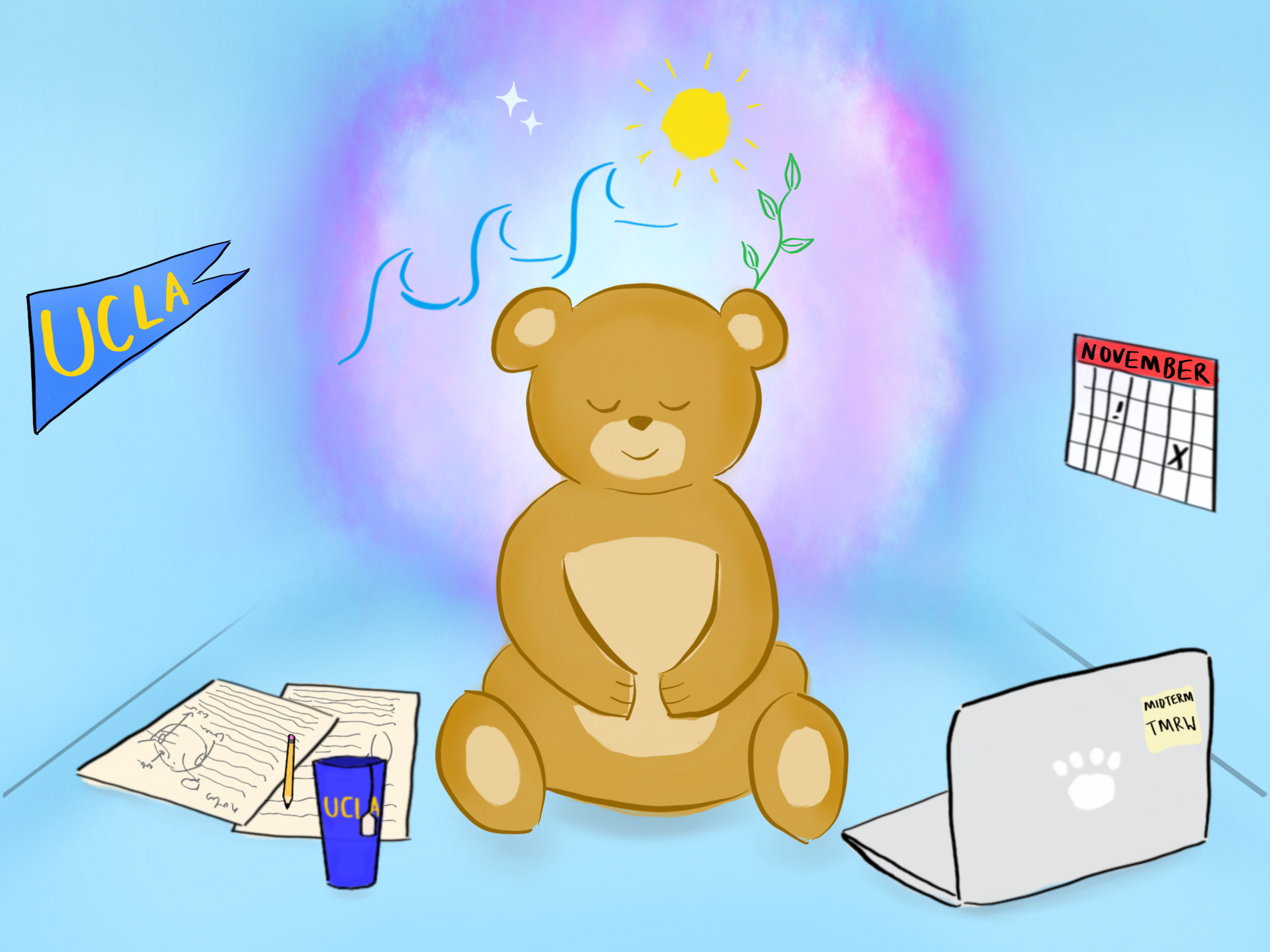The Quad: How mindful awareness techniques can carry you through the midterm season

(Elysia Ouyang/Daily Bruin senior staff)
By Kayleigh Ruller
Nov. 5, 2018 4:03 p.m.
A mindful breath was exactly what I needed when I was crying from the stressors of week five in Jimmy’s Coffee House.
My greatest study trick and trustiest companion these past few weeks has been practicing intentional breathing – a form of mindful awareness. Mindfulness is a buzzword nowadays, but what does it actually entail? According to The New York Times, mindful awareness is the awareness that arises through actively paying attention to what’s happening in the present moment without any sort of judgment.
What this means in the midst of midterm madness is that by looking at things through a thoughtful, nonjudgmental mindset, students may be able to focus much better and narrow down what is, in fact, worth stressing over.
Brian Shiers, one of the meditation teachers for UCLA’s Mindful Awareness Practices classes, offers two key mindfulness practices for students in order to cultivate sharper clarity of mind during midterms: a concentration practice and a loving-kindness meditation.
“The more concentration we have leads to more attentional stability and clarity. We can see more clearly,” Shiers said.
A quick mindful concentration technique to remember is just taking a deep inhale through your nostrils, holding it for a few seconds and then releasing it gently from your mouth, observing the breath and the sensations of the body without judgment.
Even 10 seconds of focus, although challenging, can provide a decompressing, mental relief to a fight-or-flight state of mind. You can picture any distracting thoughts as if they are flowing like a waterfall which you, as the observer, stand behind, but not directly under. The imagery of a flowing waterfall can help you witness your thoughts, rather than play victim to them.
Loving-kindness meditation focuses on sending love and forgiveness toward yourself and other people in your lives – and yes, that includes the difficult people.
Shiers said he taught the UCLA women’s varsity volleyball team these mindfulness techniques for four seasons, and each year the women found that the techniques gave them the ability to bounce back from adversity, manage stress and re-focus.
However, mindfulness isn’t just beneficial in high-stakes games – it can be implemented into the day-to-day routine of school.
“The loving-kindness meditation situates a kindness toward yourself and toward other people,” Shiers said.
Whether a student is already incorporated into a group or team or may be experiencing feelings of isolation, Shiers describes the loving-kindness meditation as tool for all students confronting different social situations as it cultivates a kindness toward yourself and toward other people.
In practicing mindfulness tactics, people can develop a kinder mentality in the midst of stress. It enables you to forgive the professors who gave you a difficult exam and assists in reducing feelings of envy or competition between students.
When one is being aware of the mind and body, the need for breaks during study sessions becomes a little more necessary. According to a 2011 study by University of Illinois psychology professor Alejandro Lleras, effective breaks and stress relievers are key to making intense periods in school, well, less intense.
However, instead of using breaks as an excuse to binge Netflix, we can reorient ourselves to seek relief in other ways and build communities rooted in mindful awareness. Rather than drowning stress in procrastination, students can combat stress and build resilience with a supportive community by their sides.
Rachel Houseworth, a second-year neuroscience student, said she rekindled her mindfulness practice alongside the supportive community she found from attending yoga classes at the John Wooden Center.
“Yoga has helped us become more compassionate and more open humans in general. It is a safe space where I look forward to seeing familiar faces,” Houseworth said. “Feeling other people’s presence and watching them find peace helps my practice.”
Yoga on campus is rapidly growing nationwide for many reasons. Not only does yoga provide students with healthy ways to express their emotions and ease anxiety from a mental standpoint, but it enhances focus, attention and memory in the classroom. These bits and pieces of yoga’s benefits create a collective growth in overall self-awareness and self-esteem. With this, it is clear that yoga and mindfulness aren’t just tactics; they’re superpowers that ought to be shared with others, inspiring one another to be our most mindful and intentional selves.
There are plenty of ways for students to explore mindfulness or simply seek out a break from the midterm madness, from the UCLA Mindful Awareness Research Center, the mindfulness drop-ins at the Hammer Museum, or yoga on the Hill outside Sunset Canyon Recreation Center. However, concentration and the loving-kindness meditation are still just one breath away to bring you back to the present moment when your day needs a pause.
“It’s critical that we remember that this present moment is the only moment. The only real experience is this moment,” Shiers said. “It’s always this moment. Then, if I can feel that, it’ll help me remember that this moment is the only moment I have to pay attention to.”

